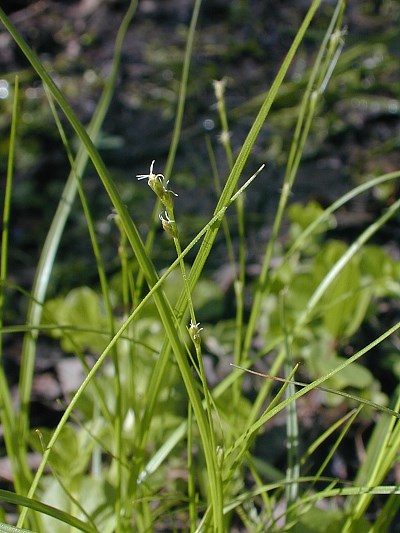Description: This perennial sedge often forms a dense tuft of leaves and culms, spanning about 1½' tall and across. The slender culms are triangular in cross-section, light green, and hairless. Several alternate leaves occur along the lower one-third of each culm. The slender leaf blades are up to 12" long and 2 mm. across, light green, and hairless; they are ascending to widely spreading and slightly to moderately recurved. The tight sheaths are light green along the two outer surfaces and translucent along the inner surface; the mouth of each sheath is usually concave.

Most of the culms
terminate in a floral spike about 1½"–3" long, consisting of 3-8
spikelets. The spikelets are more widely spaced from each other toward
the bottom of the spike than the apex. Each spikelet consists of a
tight cluster of 1-9 perigynia; these perigynia are initially erect,
but they later become slightly ascending, slightly descending, or
widely spreading, forming a star-like cluster. Underneath the lower 2-3
spikelets, there are linear leafy bracts (up to 2" in length). Male
florets, if present, are located above the female florets and their
perigynia. Each mature perigynium is about 3 mm. long and 1.5 mm.
across; it is ovoid-lanceoloid in shape, smooth across the surface, and
somewhat flattened, tapering gradually to a small beak. The pistillate
scales are about 2 mm. long, 1.5 mm. across, and ovate in shape; except
for a central green vein, they are translucent. Initially, the
perigynia are light green, but they later turn brown. Protruding from
the beak of each perigynium, there is a pair of styles about 1 mm.
long; these styles are either straight or slightly twisted. The short
blooming period occurs during the late spring. The female florets are
wind-pollinated. Each mature perigynium contains a single achene about 1.5 mm. long and 1.0 mm.
across; it is ovoid and somewhat flattened. The root system is fibrous
and short-rhizomatous. This sedge reproduces primarily by reseeding
itself into new areas.
perigynium contains a single achene about 1.5 mm. long and 1.0 mm.
across; it is ovoid and somewhat flattened. The root system is fibrous
and short-rhizomatous. This sedge reproduces primarily by reseeding
itself into new areas.
Cultivation:
A favorable environment consists of dappled sunlight to medium shade,
moist to mesic conditions, and a rich loamy soil with abundant organic
matter.
Range & Habitat:
The native Star Sedge is common throughout Illinois (see Distribution
Map). Habitats include moist to mesic deciduous woodlands,
edges of shaded seeps, and slopes of shaded ravines. Star Sedge is
found in both undisturbed and slightly degraded woodlands.
Faunal Associations:
The floral-faunal relationships of Star Sedge are similar to other
sedges, although these are strongly influenced by this sedge's fidelity
to woodland habitats. It does not provide much cover for vertebrate
wildlife, but the seeds are eaten by various songbirds and upland
gamebirds that prefer wooded habitats. Many species of insects feed on
this and other sedges; such insects are sources of food to many birds
and mammals.
Photographic Location:
A mesic deciduous woodland (Busey Woods) at Urbana, Illinois. The sedge
is blooming in the upper photograph, however the perigynia of the
inflorescence will not assume their full size until later in the season.
Comments:
Because of the dense tuft of slender leaves and star-like clusters of
the inflorescence, this medium-small sedge is rather ornamental. Star
Sedge is very similar in appearance to another common species, Carex
rosea (Curly-Style Star Sedge), which is found in the same
woodland habitats. This sedge differs from Star Sedge by its strongly
recurved styles and its slightly wider leaf blades (up to 3 mm.
across). Another similar species, Carex socialis
(Colonial Sedge), differs primarily by its long rhizomes and loose
tufts of leaves. However, this latter sedge is restricted to the
southern tip of Illinois.